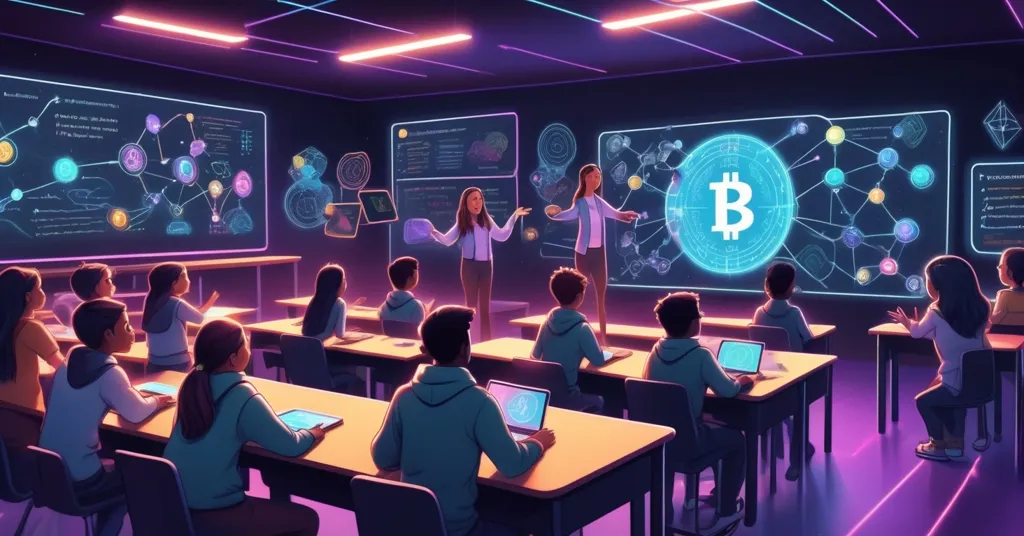New Zealand Pioneers Crypto Education in Schools by 2026, Leading Blockchain Literacy

New Zealand Sets the Stage for Crypto Literacy with Digital Currency in Schools by 2026
New Zealand is making a groundbreaking move by embedding a mandatory financial literacy program into its national curriculum starting in 2026, with a heavy focus on digital currencies and blockchain technology. This initiative, aimed at preparing students for a rapidly digitizing economy, positions the country as a potential leader in crypto education. For more details on this pioneering step, check out the full coverage on New Zealand’s digital currency education plan.
- Rollout Plan: Begins in 2026, mandatory across schools by 2027.
- Target Group: Students in years 1-10, with tailored content for different ages.
- Core Focus: From basic finances to digital assets and blockchain systems.
A Bold Overhaul of Financial Education
Education Minister Erica Stanford recently unveiled this ambitious plan, targeting students from years 1 to 10 with a progressive learning framework. For the younger crowd in years 1 through 5, the curriculum sticks to the basics—earning pocket money, spending wisely, saving for a goal, and grasping what a bank account does. Think of it as teaching the ABCs of money before jumping into quantum physics. As students move into years 6 to 10, the stakes get higher with topics like investments, taxation, insurance, and—here’s the kicker—digital assets. This isn’t just about balancing a checkbook; it’s about understanding the tech and systems behind modern payment methods, including cryptocurrencies and blockchain, that are reshaping global finance.
The need for this overhaul isn’t some bureaucratic whim. The Retirement Commission laid bare a harsh truth: only 25% of New Zealand students currently get any financial education, and what’s out there often misses the mark on national standards. That’s a massive blind spot in a world where one bad financial call in your early 20s can saddle you with debt for decades. Finance Minister Nicola Willis hammered this home, pointing out that a lack of money smarts often leads to disastrous decisions when young adults step into the real world. It’s like tossing someone into a shark tank without teaching them to swim—or even telling them sharks exist.
Hands-On Learning: From Classroom Tokens to Blockchain Sims
New Zealand isn’t messing around with outdated textbooks or yawn-inducing lectures. Their approach is practical and, frankly, pretty ingenious. For younger students, token-based reward systems will mimic real-world earning and spending—picture a classroom economy where kids “buy” privileges or supplies with tokens they’ve earned, learning value and trade-offs in a safe sandbox. As they get older, the curriculum ramps up with blockchain simulations where students can step into roles like miners (who verify transactions by solving complex puzzles with computers), nodes (computers that store the blockchain’s data), or everyday users sending digital coins. They’ll manage mock digital wallets and even track volatile market indicators like token prices. This is no abstract theory; it’s a front-row seat to the digital economy.
For those not yet in the know, let’s break down the tech. Blockchain is the backbone of cryptocurrencies like Bitcoin—a decentralized digital ledger spread across a network of computers, recording every transaction in a way that’s brutally tough to manipulate. Digital currencies, or crypto, are virtual assets built on this tech, operating without banks or governments as middlemen. They’re wildly speculative, sure, with prices swinging like a pendulum on steroids, but they’re also revolutionizing finance—from instant cross-border payments to decentralized finance (DeFi) apps. DeFi, by the way, is like an online bank run purely by code, letting you lend or borrow without a traditional institution, though it’s not without pitfalls like hacks or buggy software. Teaching this isn’t about turning kids into Wall Street wolves; it’s about showing them a fundamental shift in how value moves around the globe.
Why Digital Money Education Matters Right Now
The timing of this initiative couldn’t be more spot-on. Globally, digital currencies are no longer a fringe experiment. Bitcoin’s market cap sits in the hundreds of billions, Ethereum fuels a sprawling ecosystem of smart contracts (self-executing agreements coded on the blockchain), and even central banks are scrambling to roll out their own digital currencies, known as CBDCs. New Zealand’s push to integrate this into education shows a rare foresight—tomorrow’s adults need to understand these systems today, not when they’re already knee-deep in a world run by digital money. Historically, the country has been quick to adopt tech, from early digital payment systems to robust internet infrastructure, so this move feels like a natural extension of their innovative streak.
The Ministry of Education is pulling in heavy hitters like the Retirement Commission and other financial education providers to develop teaching materials and tools. This partnership is crucial because, let’s face it, not every teacher is ready to explain wallet private keys (unique codes that secure your crypto) or the environmental debates around Bitcoin mining (which guzzles energy like a small country). The goal is to arm educators with the know-how to teach these complex topics without turning lessons into a confusing mess or, worse, spreading half-baked info.
Risks and Challenges of Crypto Classrooms
Now, let’s play devil’s advocate and get real about the risks. Exposing young minds to speculative assets like cryptocurrencies without a relentless focus on volatility and scams is a recipe for trouble. The crypto space is a minefield—think rug pulls (projects that vanish with investor money), Ponzi schemes, or outright fraud. In 2022 alone, over $2 billion was lost to crypto scams, according to Chainalysis reports. If this curriculum doesn’t hammer home skepticism and risk management, it could breed overconfidence in markets that devour even seasoned players. Look at the Terra/Luna collapse—a so-called stablecoin imploded overnight, wiping out billions. That’s the kind of cautionary tale students need, not just the shiny promise of decentralized utopia.
Then there’s the digital divide to consider. Not every school or student has equal access to the tech needed for simulations or online resources. If implementation isn’t handled with equity in mind, this could widen gaps rather than close them. And what about teacher pushback? Some traditional educators might balk at diving into a field that moves faster than they can keep up with, especially without continuous training. The Ministry’s partnerships are a start, but they’ll need a robust plan to tackle resistance and ensure every classroom is on the same page.
A Global Blueprint for Crypto Literacy?
Despite the hurdles, there’s a lot to be optimistic about. This isn’t about churning out mini day-traders; it’s about equipping a generation to make informed choices in a reality where digital money isn’t sci-fi—it’s here. New Zealand’s experiment could set a precedent for others to follow. Compare this to places like Estonia, a tech-forward nation with digital identity systems in schools, or South Korea, where crypto adoption is sky-high among young adults. Neither has yet baked blockchain into their core curriculum at this scale. If New Zealand pulls this off, they could become the gold standard for crypto literacy, inspiring a ripple effect worldwide.
As champions of decentralization and freedom, we can’t help but cheer this disruption of stale financial education. Bitcoin maximalists might gripe that the focus isn’t laser-locked on the original cryptocurrency—and yeah, Bitcoin’s unshakeable promise of financial sovereignty without gatekeepers should be a cornerstone lesson. But let’s be pragmatic: understanding the broader landscape, including Ethereum’s innovative smart contracts or other protocols, fills gaps Bitcoin doesn’t aim to cover. Diversity in education mirrors the diversity driving this financial revolution.
What’s Next for Crypto Education?
New Zealand’s bet on financial literacy, with digital currencies and blockchain at its heart, embodies effective accelerationism—pushing boundaries to adapt to inevitable change. If executed with balance and rigor, this could redefine how the next generation views money and tech. But it’s not without pitfalls, from ensuring teacher readiness to guarding against hype in a space riddled with snake oil. Will this experiment spark a global shift in how we teach finance, or is it a risky gamble on unproven ground? Only time will tell, but one thing’s clear: the future of money isn’t waiting for anyone to catch up.
Key Questions on New Zealand’s Crypto Curriculum
- What is New Zealand’s new financial literacy program teaching about crypto?
It introduces students to digital currencies and blockchain technology, focusing on core ideas like decentralized ledgers and digital wallets through practical simulations, rather than promoting specific coins like Bitcoin or Ethereum. - How will blockchain education work for students in schools?
Younger students use token systems to learn earning and spending, while older ones (years 6-10) engage in blockchain simulations, acting as miners or users to grasp transaction verification and network dynamics. - Why is teaching digital currencies in schools important now?
With Bitcoin’s massive market presence and central bank digital currencies emerging, digital money is transforming finance—preparing students early ensures they’re ready for a decentralized future. - What are the risks of crypto education for young students?
Without a focus on volatility and scams like rug pulls, there’s a danger of fostering overconfidence in risky markets, though the curriculum prioritizes system comprehension over trading hype. - How is New Zealand preparing teachers for blockchain lessons?
The Ministry of Education is collaborating with the Retirement Commission to create materials and training, ensuring educators can teach complex topics like wallet security without misinformation. - Could this curriculum inspire global blockchain education trends?
Absolutely—New Zealand’s forward-thinking approach could become a model for other nations, especially if successful, positioning them as pioneers in crypto literacy amid rising digital asset adoption.



